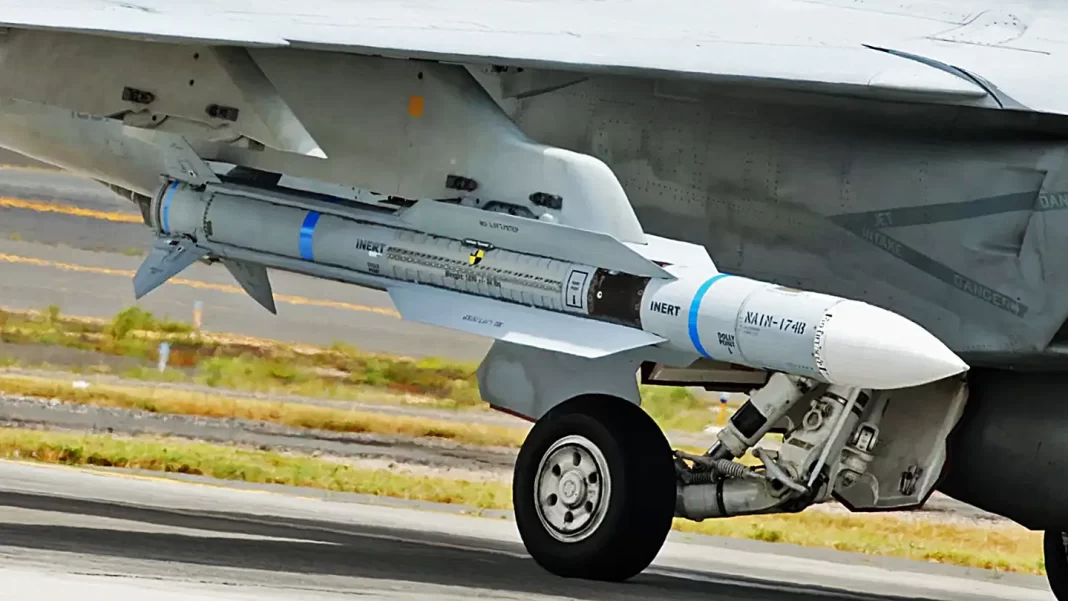The U.S. Navy has unveiled a new weapon that could change the balance of power in the Indo-Pacific region. The AIM-174B, an extremely long-range air-to-air missile, offers the U.S. military a significant advantage over China’s current capabilities. This development comes amid rising tensions in the South China Sea and growing concerns about China’s military reach.
A Game-Changer in Aerial Combat
The AIM-174B is not just another missile. It’s the longest-range air-to-air missile the United States has ever deployed. With a reach of up to 400 kilometres (250 miles), it far surpasses the range of the U.S.’s previous best option, the AIM-120 AMRAAM, which can only travel about 150 kilometres (93 miles). This means U.S. aircraft can now engage enemy targets from much farther away, keeping themselves and their carriers safer from threats.
Outmatching China’s PL-15
China’s PL-15 missile, with a range of about 250 kilometers (155 miles), has been a concern for U.S. defense strategists. The PL-15, carried by China’s stealthy J-20 fighter jets, gave China an edge, allowing them to strike U.S. aircraft before being targeted themselves. However, the AIM-174B changes this equation. With its superior range, U.S. jets can now engage Chinese aircraft from a safe distance, even before they get close enough to launch their own missiles.
Why the AIM-174B Matters
The new missile’s long range isn’t its only advantage. It also benefits from being based on the existing SM-6 air defense missile, which means it doesn’t require new production lines. The U.S. can produce these missiles quickly and efficiently, ensuring they are readily available. Additionally, the AIM-174B is compatible with the F/A-18E/F Super Hornet, an aircraft used by both the U.S. and Australian militaries. This makes it easier to integrate into allied forces, enhancing collective defense in the region.
Implications for Regional Security
The deployment of the AIM-174B could significantly impact military dynamics in the South China Sea. The U.S. Navy, operating within a few hundred kilometers of Chinese territory, can now push further into contested areas with greater safety. The missile’s range allows U.S. forces to strike high-value Chinese targets, such as command-and-control planes, without putting their own assets at risk. This capability could deter China from aggressive actions in the region, as their aircraft would face a greater threat from U.S. forces.
A Broader Strategy
The development of the AIM-174B is part of a broader strategy to counter China’s growing military capabilities. The U.S. has relied on stealth technology for decades, but the emergence of advanced Chinese missiles like the PL-15 required a new approach. The AIM-174B, along with other projects like the secretive AIM-260 missile, represents a shift towards longer-range engagement, allowing U.S. forces to maintain their edge even as China modernises its military.
Future Considerations
While the AIM-174B is a powerful addition to the U.S. arsenal, it also raises questions about future conflicts in the Indo-Pacific. If the missile can push Chinese aircraft further back, it could reduce the need for large numbers of these missiles. The mere presence of such a capable weapon might change Chinese military strategies, forcing them to reconsider their approach to regional conflicts.
Future Prospects
The AIM-174B is more than just a new missile; it’s a strategic tool that could reshape the balance of power in the Indo-Pacific. By extending the reach of U.S. aircraft and countering China’s missile advantage, the AIM-174B enhances the U.S. military’s ability to protect its interests and those of its allies in a region where tensions are high. As the U.S. continues to innovate and adapt, the AIM-174B will likely play a crucial role in maintaining stability in the Indo-Pacific.

